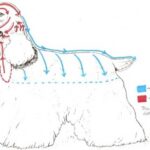Caroline looked at the graying muzzle of her 12-year-old black American Cocker Spaniel, Joy, as she telephoned the vet. Although she worried that the elderly dog would develop cancer like her prior Cocker, she had never expected Joy to suddenly stumble and fall while trying to navigate the only home she’d ever known. The vet diagnosed the culprit as canine vestibular syndrome.
What is Vestibular Syndrome in Dogs?
To really understand this disorder, it’s essential to realize how a dog’s vestibular system works. According to PetPlace.com, it’s largely responsible for keeping the pet’s head and body in the proper orientation in relation to gravity. The system tells the animal’s brain whether the current position is standing, lying down, falling, going in circles or sitting. This allows the dog’s body to stay balanced.
Nerves that originate in the dog’s brain and lead to the inner ear make up the vestibular system. Sensors located in the inner ear pick up information and alert the brain to any movement. The body of a dog with vestibular syndrome can’t recognize abnormal positions. The brain also lacks the capacity to correct them.
Causes
Problems with the vestibular system tend to appear in dogs with an average age of 12 to 13. Vestibular syndrome can strike when the nerves in the brain or inner ear fail to develop properly.
For some dogs, infections of the inner ear can destroy nerves in that area and create the disorder. However, quite often, there is no apparent reason why a dog develops this illness beyond its tendency to occur in older dogs, Vetinfo reports.
Signs and Symptoms
The signs of vestibular syndrome in dogs are very apparent and sometimes extremely frightening to owners. It’s easy to mistakenly assume the dog has had a stroke.
A number of symptoms mean that an affected dog needs medical attention. They include showing a lack of coordination, a lack of ability to walk straight, the inability to get up and stumbling or falling when trying to walk. If a dog rolls his or her eyes or appears to have a lack of interest in everyday activities, it’s time to contact a veterinarian.
Diagnosis and Treatment
Fortunately, vets have a number of ways to evaluate a dog for vestibular syndrome. Evaluation usually starts with blood tests and a urinalysis to rule out other conditions. Dogs with the symptoms of this disorder require a complete ear exam. In severe cases of the syndrome, vets will order X-rays or CT scans of the brain to make sure the dog has no tumors there.
The final diagnosis of vestibular syndrome is the result of ruling out all other possible causes of symptoms.
There is no way to reverse this condition because it’s an indication that nerve function has been lost. Treatment centers on relieving the dog’s symptoms. Most vets will consider prescribing a motion sickness drug like meclizine for the pet for an indefinite period.
Dogs with this ailment need good home care. Owners should not leave the dog in the house with the opportunity to roam when unsupervised. These dogs cannot run free in unfenced yards. Due to the loss of coordination associated with vestibular syndrome in dogs, affected pets can no longer judge distance and speeds of passing vehicles.
Sources:
http://www.petplace.com/dogs/vestibular-disease-in-dogs/page1.aspx
http://www.vetinfo.com/vestibular-syndrome-dogs.html





